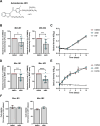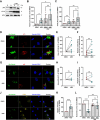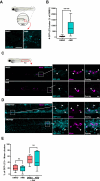Host-directed therapy with amiodarone in preclinical models restricts mycobacterial infection and enhances autophagy
- PMID: 38916320
- PMCID: PMC11302041
- DOI: 10.1128/spectrum.00167-24
Host-directed therapy with amiodarone in preclinical models restricts mycobacterial infection and enhances autophagy
Abstract
Mycobacterium tuberculosis (Mtb) as well as nontuberculous mycobacteria are intracellular pathogens whose treatment is extensive and increasingly impaired due to the rise of mycobacterial drug resistance. The loss of antibiotic efficacy has raised interest in the identification of host-directed therapeutics (HDT) to develop novel treatment strategies for mycobacterial infections. In this study, we identified amiodarone as a potential HDT candidate that inhibited both intracellular Mtb and Mycobacterium avium in primary human macrophages without directly impairing bacterial growth, thereby confirming that amiodarone acts in a host-mediated manner. Moreover, amiodarone induced the formation of (auto)phagosomes and enhanced autophagic targeting of mycobacteria in macrophages. The induction of autophagy by amiodarone is likely due to enhanced transcriptional regulation, as the nuclear intensity of the transcription factor EB, the master regulator of autophagy and lysosomal biogenesis, was strongly increased. Furthermore, blocking lysosomal degradation with bafilomycin impaired the host-beneficial effect of amiodarone. Finally, amiodarone induced autophagy and reduced bacterial burden in a zebrafish embryo model of tuberculosis, thereby confirming the HDT activity of amiodarone in vivo. In conclusion, we have identified amiodarone as an autophagy-inducing antimycobacterial HDT that improves host control of mycobacterial infections.
Importance: Due to the global rise in antibiotic resistance, there is a strong need for alternative treatment strategies against intracellular bacterial infections, including Mycobacterium tuberculosis (Mtb) and non-tuberculous mycobacteria. Stimulating host defense mechanisms by host-directed therapy (HDT) is a promising approach for treating mycobacterial infections. This study identified amiodarone, an antiarrhythmic agent, as a potential HDT candidate that inhibits the survival of Mtb and Mycobacterium avium in primary human macrophages. The antimycobacterial effect of amiodarone was confirmed in an in vivo tuberculosis model based on Mycobacterium marinum infection of zebrafish embryos. Furthermore, amiodarone induced autophagy and inhibition of the autophagic flux effectively impaired the host-protective effect of amiodarone, supporting that activation of the host (auto)phagolysosomal pathway is essential for the mechanism of action of amiodarone. In conclusion, we have identified amiodarone as an autophagy-inducing HDT that improves host control of a wide range of mycobacteria.
Keywords: Mycobacterium avium; Mycobacterium marinum; Mycobacterium tuberculosis; amiodarone; host-directed therapy; human macrophages; zebrafish.
Conflict of interest statement
The authors declare no conflict of interest.
Figures




References
-
- Global tuberculosis report 2023. 2023. Licence: CC BY-NC-SA 30 IGO. 2023. Geneva: World Health Organization
-
- Cilloni L, Fu H, Vesga JF, Dowdy D, Pretorius C, Ahmedov S, Nair SA, Mosneaga A, Masini E, Sahu S, Arinaminpathy N. 2020. The potential impact of the COVID-19 pandemic on the tuberculosis epidemic a modelling analysis. EClinicalMedicine 28:100603. doi:10.1016/j.eclinm.2020.100603 - DOI - PMC - PubMed
MeSH terms
Substances
Grants and funding
LinkOut - more resources
Full Text Sources
Medical
Molecular Biology Databases

